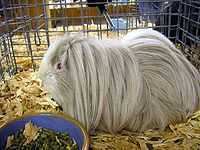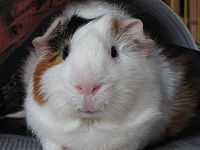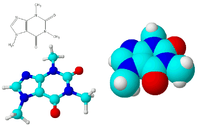Molecular genetics

Molecular genetics, unlike transmission genetics, focuses on the molecular level, that is, on DNA, proteins, genes, chromosomes and the like. Molecular genetics does not care so much about the trait itself being transferred to offspring, but more so on how traits in general are transferred to offspring. How can chemical information locked within DNA be transformed into facial features or vocal ability in our children?
Of course, the genetic molecule is DNA, or Deoxyribonucleic acid. DNA is made up of phosphate groups, a deoxyribose sugar, and a nucleotide. There are four nucleotides in DNA, Adenine, Thymine, Cytosine, and Guanine. Adenine binds to Thymine with two hydrogen bonds and Cytosine binds to Guanine with three hydrogen bonds. There is another nucleotide base called Uracil that is only found in RNA, a similar but different molecule from DNA. The phosphate groups are negatively charged and form the backbone of the DNA molecule with the nucleotide bases forming the center. The molecule twists to the right in a clockwise fashion to form a double helix.
When DNA is replicated it is typically in this loose, unbound form. During mitosis or meiosis, the DNA is supercoiled and bunched together with proteins called histones. This is what typically forms what we know as chromosomes during metaphase.
Genetics

Genetics involves the expression, transmission, and variation of inherited characteristics.
Def. a "branch of biology that deals with the transmission and variation of inherited characteristics, in particular chromosomes and DNA"[1] is called genetics.
Molecules

Def. the "smallest particle of a specific element or compound [that retains the chemical properties of that element or compound]; a group of atoms held together by chemical bonds"[2] is called a molecule.
Theoretical molecular genetics
Def. a "field of biology which studies the structure and function of genes at a molecular level"[3] is called molecular genetics.
Research
Hypothesis:
- Molecules that affect genetics should be enumerated.
Control groups

The findings demonstrate a statistically systematic change from the status quo or the control group.
“In the design of experiments, treatments [or special properties or characteristics] are applied to [or observed in] experimental units in the treatment group(s).[4] In comparative experiments, members of the complementary group, the control group, receive either no treatment or a standard treatment.[5]"[6]
Proof of concept
Def. a “short and/or incomplete realization of a certain method or idea to demonstrate its feasibility"[7] is called a proof of concept.
Def. evidence that demonstrates that a concept is possible is called proof of concept.
The proof-of-concept structure consists of
- background,
- procedures,
- findings, and
- interpretation.[8]
See also
References
- ↑ "genetics, In: Wiktionary". San Francisco, California: Wikimedia Foundation, Inc. April 16. 2014. Retrieved 2014-05-07.
- ↑ SemperBlotto (12 January 2005). "molecule, In: Wiktionary". San Francisco, California: Wikimedia Foundation, Inc. Retrieved 2016-01-09.
- ↑ Pumpie (27 August 2005). "molecular genetics, In: Wiktionary". San Francisco, California: Wikimedia Foundation, Inc. Retrieved 2016-01-09.
- ↑ Klaus Hinkelmann, Oscar Kempthorne (2008). Design and Analysis of Experiments, Volume I: Introduction to Experimental Design (2nd ed.). Wiley. ISBN 978-0-471-72756-9. http://books.google.com/?id=T3wWj2kVYZgC&printsec=frontcover.
- ↑ R. A. Bailey (2008). Design of comparative experiments. Cambridge University Press. ISBN 978-0-521-68357-9. http://www.cambridge.org/uk/catalogue/catalogue.asp?isbn=9780521683579.
- ↑ "Treatment and control groups, In: Wikipedia". San Francisco, California: Wikimedia Foundation, Inc. May 18, 2012. Retrieved 2012-05-31.
- ↑ "proof of concept, In: Wiktionary". San Francisco, California: Wikimedia Foundation, Inc. November 10, 2012. Retrieved 2013-01-13.
- ↑ Ginger Lehrman and Ian B Hogue, Sarah Palmer, Cheryl Jennings, Celsa A Spina, Ann Wiegand, Alan L Landay, Robert W Coombs, Douglas D Richman, John W Mellors, John M Coffin, Ronald J Bosch, David M Margolis (August 13, 2005). "Depletion of latent HIV-1 infection in vivo: a proof-of-concept study". Lancet 366 (9485): 549-55. doi:10.1016/S0140-6736(05)67098-5. http://www.ncbi.nlm.nih.gov/pmc/articles/PMC1894952/. Retrieved 2012-05-09.
External links
- African Journals Online
- Bing Advanced search
- GenomeNet KEGG database
- Google Books
- Google scholar Advanced Scholar Search
- Home - Gene - NCBI
- JSTOR
- Lycos search
- NASA's National Space Science Data Center
- NCBI All Databases Search
- Office of Scientific & Technical Information
- PubChem Public Chemical Database
- Questia - The Online Library of Books and Journals
- SAGE journals online
- The SAO/NASA Astrophysics Data System
- Scirus for scientific information only advanced search
- SpringerLink
- Taylor & Francis Online
- WikiDoc The Living Textbook of Medicine
- Wiley Online Library Advanced Search
- Yahoo Advanced Web Search
| |||||||||||||||||||||||||||||||||||||||||
| ||||||||||||||||||||||||||||||||||||||||||||
| |||||||||||||||||||||||||||||||||||
![]() This is a research project at http://en.wikiversity.org
This is a research project at http://en.wikiversity.org
| |
Development status: this resource is experimental in nature. |
| |
Educational level: this is a research resource. |
| |
Resource type: this resource is an article. |
| |
Resource type: this resource contains a lecture or lecture notes. |
| |
Subject classification: this is a biochemistry resource. |
| |
Subject classification: this is a genetics resource. |